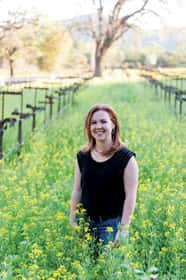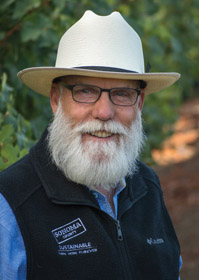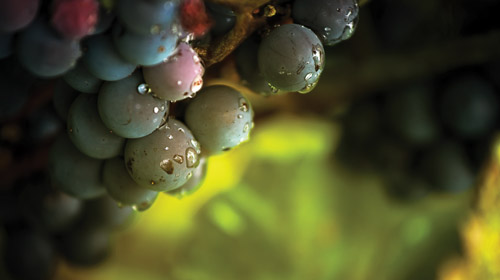There’s no argument that the wine in your glass showcases the skill of the winemaker. Yet it was Mother Nature who engineered the growing season that made it all possible. Rain at the right time and in the right amount, the absence of damaging frost, the welcome cooling from the marine layer after a string of hot days––these fluctuations of the weather all contributed to the flavors in the bottle.
Several years of drought followed by record winter rainfall in the North Bay brought about vigorous growth in the vineyards this summer. “With the warm weather after a wet winter and spring, the vines just took off,” says Matt Crafton, head winemaker at Chateau Montelena in Calistoga. “And we want that period of grand growth because all of those leaves are like solar panels for the fruit.”
The emergence from the drought, with some areas awash in two to three times as much rain as the previous year, made headlines nationwide. And Wine Country visitors this year are understandably curious about the 2017 vintage.
 Harvest predictions
Harvest predictions
The harvest is expected to follow an average pre-drought timeline, says Karissa Kruse, president of the Sonoma County Winegrape Commission, and the average grape yield may be up slightly versus 2016.
“During the drought years, picking began a little earlier than usual. In fact, for the last couple of years Sonoma County was wrapping up harvest in late September or early October,” she says. “This year there should still be some picking going on into October during the Harvest Fair.”
Kruse is also hearing that the grape crop looks a bit heavier than last year, but at press time, it was still too early to predict. “As the old adage goes, we’ll know the first night we harvest what the harvest will be like.”
Grapegrowing in the North Bay was not impacted as severely by drought as agriculture in the Central Valley and Southern California, she adds. “We had low but almost average rainfall during those declared drought years. And, ultimately, farmers know how to deal with weather. They adapt to unpredictability and are used to Mother Nature throwing them curve balls.”
Water, water everywhere
By the end of March this year, Sonoma County had received 225 percent of normal precipitation. Healdsburg averages 40 inches of rain in a normal season, but this past year it received around 70 inches, according to Duff Bevill, owner of Bevill Vineyard Management in Healdsburg. At a certain point, he says, all of that extra rainfall, which is great for filling reservoirs and ponds, doesn’t do the farmer any good.
“The soil can only hold so much water, and the extra runs off the fields and into creeks and rivers and out to the ocean,” he explains. “The amount of extra rain we receive has no bearing on how big or little next year’s crop will be. We had enough rain this year to assure the vines in general are very healthy—not water stressed—and have been exceptionally vigorous.”
The downside of a very wet winter and spring, however, are work delays, says Crafton. “It can be difficult getting crews and equipment into wet fields when work needs to be done. If weather delays one part of your plan, everything else gets backed up. You have to fully finish Step A before you can move forward to Steps B and C, normally But it’s been great to have the ‘problem’ of a full soil profile, meaning the soil is holding as much water as it can, because those are the reserves the vines need to pull from over the course of the growing season. However, when we can’t get crews in early, we have to wait for a window of dry weather, which can present logistical challenges.”
 Fear of frost
Fear of frost
The vast majority of Chateau Montelena’s fruit is grown in the Calistoga AVA, says Crafton. “We also have a ranch in the Oak Knoll district where we grow Chardonnay, and we consistently see distinct weather patterns between the northern and southern parts of Napa Valley. It’s always wetter in the winter in Calistoga, and sometimes we get more than twice the rainfall as the south valley. Calistoga also has more well-drained soils compared to the south valley.”
“The vines got to drink their fill this winter,” says Kendall Hoxsey-Onysko, business manager for Napa Wine Company, a custom crush operation, and Yount Mill Vineyards in Oakville. In early spring, when the vines are emerging from dormancy, they become vulnerable to freezing overnight temperatures. “We typically see bud break in March, but sometimes it’s been as early as January in recent years. After bud break, we have to watch out for frost.”
Earlier this year, France had devastating frosts that plundered the young shoots on crops in Champagne, Bordeaux and Burgundy. Reported estimates claim about a quarter of the vine shoots in Champagne alone were destroyed, and several thousand hectares in Bordeaux were severely damaged. Farm union officials called it the worst frost damage to France’s grape crop in almost 30 years.
“My great grandfather, Andrew Pelissa, used to wring his hands about the weather,” says Hoxsey-Onysko, a fifth-generation grapegrower. “I remember hearing stories from the 1970s about how much money he spent on fuel oil for items like smudge pots [to fight frost], which we don’t use anymore. Every grapegrower in the valley has put away the smudge pots because we now work hard to minimize unnecessary burning in the vineyards.”
Her family owns 1,000 acres in Napa Valley––600 acres planted to 19 different grape varietals and 400 hillside acres where free-roaming cattle provide natural fire suppression. Approximately 45 percent of the grapes her family grows are Cabernet Sauvignon.
“California is lucky when it comes to weather, compared to some other grapegrowing regions of the world,” she says. “France had bad frosts this year, South America has been hard hit by a lot of rain and pest problems and New Zealand also is dealing with rain. But in California we know the rain is coming in late fall, and our weather stays pretty consistent much of the time. We’re usually not in danger of experiencing severe weather issues that some other places face.”
 Hot summer days
Hot summer days
When summer rolls around, a balance of heating and cooling from the North Bay’s natural air conditioning is crucial to maturing the grapes. By mid-August, there was no reported fruit damage resulting from the frequent, but mostly short-lived heat spikes over Napa and Sonoma counties.
“Calistoga was up in the 105-degree range yesterday [in late July],” says Crafton. “But that peak temperature may last only a short while, so we’re more concerned with the duration of the heat when it comes to the health of the vines. If the day begins at 60 degrees, then reaches 100-plus before falling back down into the 50s or 60s again in the early evening, that doesn’t bother us. The Cabernet vines really benefit from the heat of the day, at least up to a point. When the temperature hits the mid-90s, the vines begin to shut down, like many other plants do. Vines are very resilient. They love the run-up to the heat because it gets the fruit ripening, but at super high temperatures they say ‘enough!’ for self-preservation. Then they perk back up again at night.”
Several days of heat in the summer are good for the vines, says Hoxsey-Onysko. “Grapevines actually like a little stress, so you want to stress them. And once they begin to bloom, you want temperatures to be consistent. But when it gets around 95 degrees during the day too early in the growing season, we can have poor berry set which affects overall uniformity.”
This year it’s been warm, very consistently, she adds, so much so that her family’s grapes used in making sparkling wine were fast reaching their optimum sugar content, or Brix, in early August.
“I’m waiting to hear from one of the sparkling wineries about when they want to set a date to start harvesting,” she says in the same week that temperatures in Napa Valley were forecast to reach the mid-90s for seven straight days. “Last year we started picking on August 2, and I think we’ll be a week later this year, which isn’t bad. The crop size is good, and I’ve heard from others that their cluster counts look good, so it should be a great harvest.”
 A kiss of fog
A kiss of fog
From the time the vines begin pushing out their shoots until the grapes are ready to harvest, growers hope to avoid hot and cold temperature extremes.
“We need warm weather for a few days and then a cycle of fog,” explains Bevill about most of the Sonoma County vineyards he owns and manages. “Each of those fog cycles, every seven to 10 days, pushes forward the maturing process. It’s not all about sugar, but about flavor. The marine influence slows down, or tempers, the speed of maturity of the grapes and gives them time to develop their flavors.”
But too much fog and high humidity for too long––and/or the onset of rain at the wrong time––can set the stage for “noble rot” (botrytis cinerea), a fungus that can wipe out a crop. “We need to get through the harvest without rain. Rain just before and during harvest can be detrimental,” adds Bevill. “When you have to remove the moldy clusters prior or during harvest, you start losing money.”
In mid-August he anticipated harvest would take place on an average timeline, with picking of the early varietals, the Chardonnay and the Pinot Noir for making sparkling wine and the Pinot Noir, starting in late August. “But if it turned foggy and cool and remained that way, it could delay harvest by days or weeks.”
For growing wine grapes, “weather is a big deal,” adds Bevill. “I don’t mean global weather, but the day-to-day weather you wake up to every morning. The weather is why the wines all taste different from year to year.”
Viva la différence
Crafton says premium wineries take advantage of weather conditions to show off how that weather can be interpreted in the bottle.
“Warmer seasons can taste different from cooler ones, and really good wine producers––and I consider Chateau Montelena to be one––highlight those differences and use those stylistic nuances. Variety is the spice of life, and I encourage wine drinkers to seek out producers who don’t want to make the same wine year after year. It’s those differences that make wine so wonderful compared to other beverages that are standardized and homogenized.”
Hoxsey-Onysko says consumers should appreciate the wines they enjoy that are produced in the North Bay. “This is such an ideal spot for growing because the weather is consistently ideal, and thank goodness our ancestors recognized that fact.”
Still, when it comes to the weather, the devil can be in the details. Kruse likes to share a quote she attributes to Duff Bevill: “If you’re going to dance with Mother Nature, you have to remember that she always leads.”
Author
-

Jean Doppenberg is a lifelong journalist and the author of three guidebooks to Wine Country.
View all posts




